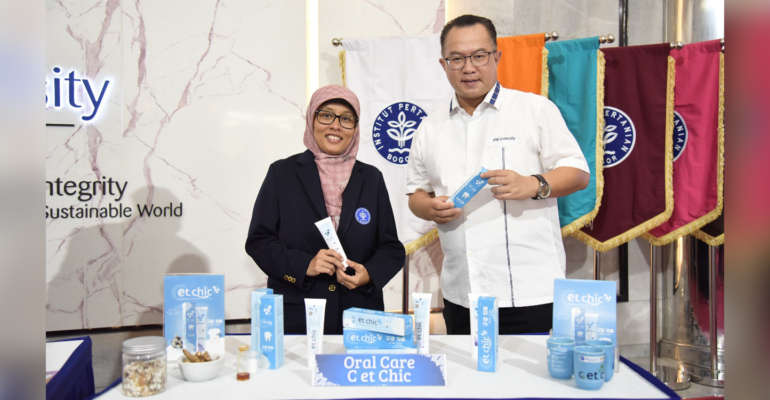IPB University Researchers Develop ‘c et chic’, Hydroxyapatite-Fortified Oral Care and Black Temu Oil Help Lower Dental Caries Tendency in Indonesia

IPB University’s research team from the Department of Physics, Department of Chemistry, Centre for Tropical Biopharmaca Studies, and Business School succeeded in making ‘c et chic’ oral care fortified with hydroxyapatite and black ginger oil. This research was funded by the Education Fund Management Agency (LPDP) of the Ministry of Finance of the Republic of Indonesia under the Invitation Innovative-Productive Research (Rispro) funding scheme.
“Oral care ‘c et chic’ has the potential to prevent dental caries in Indonesia. Currently, ‘c et chic’ oral care has obtained a distribution permit from the Food and Drug Supervisory Agency (BPOM) with number: POM NA 18241400066 and halal MUI. This product is ready to be marketed in the near future,” explained Dr Yessie Widya Sari, leader of the research team.
Preclinical research on the benefits of ‘c et chic’ oral care conducted by Dr Yessie and the team showed that hydroxyapatite is proven to help the process of tooth remineralisation. In addition, black temu oil is proven to have antibacterial and antiplaque effects on teeth. Several research results have been published in international and national journals. In addition, this oral care also received an award from the Business Innovation Centre as the 113 most prospective innovations in Indonesia.
“Based on clinical trials conducted by the IPB Clinic dental team on ‘c et chic’ oral care, there has been a reduction in plaque and debris in respondents within only 3 weeks. In addition, other benefits felt by most respondents are whitening or brightening teeth, reducing bad breath, preventing plaque formation, and relieving toothache,” she explained.
Background of ‘c et chic’ Innovation
Oral health is an investment for every individual. It is very important because it is related to one’s quality of life which cannot be separated from one’s general body health.
Based on data from the Indonesian Ministry of Health and the World Health Organization (WHO), cases of tooth decay, especially dental caries (cavities), are the most common cases both nationally and internationally. This case occurs at almost all ages, reaching 60-90 per cent of people, with the highest prevalence occurring in children at 50-70 per cent.
Dr Yessie as the innovator explained that dental caries is caused by the process of tooth demineralisation. The process of tooth demineralisation is one of the early stages of tooth decay caused by acids formed from food debris and bacteria in the mouth. In the demineralisation process, important minerals such as calcium, phosphate, and fluoride present in the outer layer of the tooth are slowly released and dissolved in acid. This results in tooth decay, cavities and tooth fractures.
The demineralisation process occurs due to the activity of microorganisms in the destruction of organic substances to bacterial invasion into the inside of the tooth from denton to pulp. This process occurs in an environment with an acidic pH below 5,5 and causes the formation of small pores or porosity on the enamel surface that did not exist before.
“One of the treatments for dental caries is the use of hydroxyapatite mineral, which is the main mineral of bone and teeth, to cover pores and holes in the teeth. Hydroxyapatite is the most stable calcium phosphate phase and has high mechanical strength,” explains Dr Yessie.
So far, the dependence on imported materials is very high, resulting in relatively expensive prices. Therefore, there is a need for local hydroxyapatite products that can reduce dependence on imported products at a relatively affordable price.
“Hydroxyapatite has similar chemical properties to human hard tissues, namely bones and teeth. This is what underlies the use of hydroxyapatite in the treatment of bone and tooth cases,’ she said.
In an effort to fulfil the domestic demand for hydroxyapatite, an optimisation of hydroxyapatite synthesis methods has been carried out. Research conducted by Dr Yessie and a team of other IPB University researchers has succeeded in producing commercial-scale hydroxyapatite through microwave techniques. This technique has received a patent with the number IDP000064247.
In addition to remineralisation of cavities, the presence of other benefits such as antiplaque and antibacterial in oral care products is very important. One of the active ingredients that can be used is black temu oil.
“The results of research on black temu rhizome oil show that black temu oil has advantages as antibacterial, antiplaque, and anti-inflammatory,” she said.
Adequate scientific support for the potential of the active ingredient (black temu rhizome oil) is expected to strengthen the product development. Dr Yessie said, to this day, there are no commercial oral care products that contain black temu rhizome oil as an active ingredient for antibacterial, antiplaque, and anti-inflammatory, so the opportunity for product development is very wide open.
Black temu rhizome oil is obtained from the extraction of black temu simplisia. Simplisia is obtained through a drying process. Standard simplisia is simplisia that has met the quality requirements set by the Indonesian Ministry of Health, including meeting the specified standard water content.
According to the Indonesian Herbal Pharmacopoeia (RI, 2008) and the Decree of the Indonesian Minister of Health No. 661/Menkes/SK/VII/1994 concerning Traditional Medicine Requirements, the standard maximum moisture content of simplisia is 10 per cent. The moisture content of temu hitam rhizomes when harvested ranges from 80-90 per cent so they need to be dried.
Dr Yessie and her team hope that the presence of ‘c et chic’ oral care in the community will reduce the tendency of dental caries in Indonesia. (*/Rz) (IAAS/RUM)



